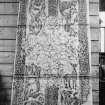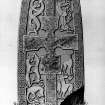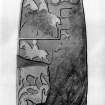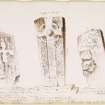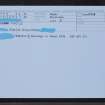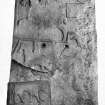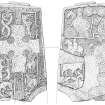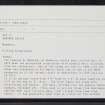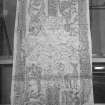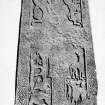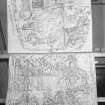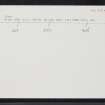Woodrae Castle
Cross Slab(S) (Pictish), Pictish Symbol Stone(S) (Pictish)
Site Name Woodrae Castle
Classification Cross Slab(S) (Pictish), Pictish Symbol Stone(S) (Pictish)
Alternative Name(s) Woodwray
Canmore ID 34845
Site Number NO55NW 6.01
NGR NO 5185 5663
Datum OSGB36 - NGR
Permalink http://canmore.org.uk/site/34845
- Council Angus
- Parish Aberlemno
- Former Region Tayside
- Former District Angus
- Former County Angus
Woodwrae 1, Angus, Pictish cross-slab
Measurements: H 1.80m, W 0.78m>0.63m, D 0.13m
Stone type: sandstone
Place of discovery: NO 5185 5663
Present location: National Museums Scotland, Edinburgh (IB 202)
Evidence for discovery: found around 1819 in the floor of the kitchen ‘when the foundations of the old castle were cleared away’. The estate factor had it sent to his friend, Sir Walter Scott, at Abbotsford, where it stood in the garden until 1924, when it was given to the National Museum of Antiquities of Scotland in Edinburgh. The defacement of the cross suggests that there may have been an intention, prior to its re-use as a kitchen paving slab, to re-use it as a graveslab with an inscription in place of the decoration. It has been suggested that the slab derived from the old burial ground at Aikenhatt, a little to the south-west of Woodwrae (Ritchie 1995, 8).
Present condition: the base of the slab is broken, the carving on the cross on face A has been carefully chipped away and face C is very damaged.
Description
The slab tapers towards the top, where there is a tenon, 0.30m long and 0.03m high (no attempt was made to correct the slope of the top). Both faces A and C are carved in relief, but the narrow faces are plain.
Face A has an elaborately ornamented frame, filled with interlace patterns down the sides and spirals along the top. The top of the frame extends in a central band to meet the top arm of the cross. Below the side-arms the voids in the interlace form crosses, and above the arms the interlace pattern is arranged so as to form crosses. The main cross is equal-armed with cusped arms and open rounded armpits, which is borne on a shaft filled with interlace, key pattern and spirals. The side-arms of the cross extend into the ornamental frame of the slab, giving an illusion of perspective. The careful defacement of the cross may suggest that it bore a depiction of Christ crucified (Henderson 1993, 213). The background is entirely filled with monster imagery. To the left of the top arm is an entwined pair of goggle-eyed serpents, while to the right there is a beast from whose jaws protrude a pair of human legs and whose tail ends in a goggle-eyed serpent’s head. Flanking the lower arm and shaft are on the left, two animals grasping each other’s hind leg in their jaws, and below them an animal with its head in the mouth of another animal. On the right is first an animal standing with its head turned to look outwards, and below another animal with a smaller creature hanging from its jaws. The head survives of another animal below the last. All the intact animals have bird’s feet.
Within a plain flat-band border on face C are, at the top a horserider moving towards the left and behind him a double disc symbol and a step symbol. The discs have two concentric inner incised lines, and there is an oval within the surviving part of the step symbol. Rider and symbols are separated from the images below by a stepped roll moulding. Two horsemen and a hound are moving from right to left below the separating moulding, and the rest of face C is obliterated by wear and flaking, except for one area on the lower left. Here a bull is depicted above a lizard-like creature perched on the back of an animal with a very large ear: the lizard is biting its neck. Allen adds that ‘the tail of the reptile is interlaced with the two hind legs of the beast’, although this is not shown on the drawing in ECMS and no longer survives.
Date range: eighth or ninth century.
Primary references: Jervise 1857, 194; ECMS pt 3, 242-5; Henderson 1993; Ritchie 1995; Fraser 2008, no 73.
Desk-based information compiled by A Ritchie 2018.
Woodwrae 2, Angus, Pictish cross-slab?
Measurements:
Stone type:
Place of discovery: NO 5185 5663
Present location: lost
Evidence for discovery: found around 1819 in the floor of the kitchen ‘when the foundations of the old castle were cleared away’. It ‘lay carelessly about for many years, and at length disappeared altogether’.
Present condition:
Description
The stone was said to be ‘much mutilated, bearing similar carvings’ to Woodwray 1.
Date range:
Primary references: Jervise 1857, 194.
Desk-based information compiled by A Ritchie 2018.
NO55NW 6.1 5185 5663
The remains of Woodrae, or Woodwray Castle were cleared away in 1819 when two sculptured cross-slabs with symbols were recovered from the foundation. One of the slabs was lost by 1854, but the other was presented to Sir Walter Scott and is now in the National Museum of Antiquities of Scotland (NMAS) presented by Lt Col Maxwell-Scott of Abbotsford in 1924 (Accession no. IB 202).
It is an upright cross-slab 5'9" high by 3'4" at base tapering to 2'9" at the top by 5" thick. The front bears the cross with interlacing and beasts. The back, divided into two panels, bears symbols, horsemen etc. (This slab is so like those from Aberlemno (NO 522 555) only 1/2 mile away, that it must have come from there.) It had apparently been used as a slab for the kitchen floor.
J R Allen and J Anderson 1903; A Jervise 1859; Proc Soc Antiq Scot 1924.
Reference (1980)
The slab in the museum has metric dimensions of 1.75mx 1m x 0.12m. The front bears an interlaced cross surrounded by beasts; the back is divided into panels containing a galloping horseman, double-disc and step symbols, and the lower panels show horsemen, monsters and beasts.
Information from R Jones 1980.
Note (1983)
Woodrae Castle, Aberlemno NO 518 566 NO55NW 6
Of the two Pictish cross-slabs discovered when Woodrae Castle was demolished about 1819, only one, a Class II stone, now survives (NMAS IB 202).
RCAHMS 1983
(Jervise 1857a, 194; Allen and Anderson 1903, iii, 242-5; PSAS, Iv iii 1923-4, 100).
Reference (1997)
Class II symbol stone. The cross face bears panels of interlace and fantastic figures, and the reverse, a mounted figure to the left of a double-disc above a step symbol.
A Mack 1997




















